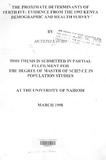| dc.description.abstract | The main objective of this study was to determine the fertility levels and differentials of various
sub-groups in Kenya and to explain these differentials using the intermediate fertility variables. The subgroups
considered in the study were the regions, place of residence, and levels of education. The
intermediate fertility variables that were studied were postpartum infecundability, non-marriage and
contraception.
The study used the Bongaarts' model to estimate the indices for each intermediate fertility
variable and also to estimate the resulting total fertility rates for each sub-group. These fertility rates
were compared with those obtained from the Gomperrtz relational model which was chosen as.an
independent method of estimating fertility. The Bongaarts' -Kirmeyer regression equation of predicting
fertility rate given the contraceptive prevalence rate was also used to predict fertility by the regions.
The data used in this study was the Kenya demographic and health survey conducted in 1993.
The study found out that there was a general trend of decline in fertility among the regions,
place of residence and by the levels of education between the period 1989 and 1993. The study also
, .
showed that at the national level as well as among five of the seven regions, the index of postpartum
infecundability was the lowest followed by that of non-marriage, then contraception. This implies that
the most important fertility inhibiting variable was lactation, followed by non-marriage, then
contraception. This agreed closely with Wamalwas' findings of 1991 using the 1989 Kenya
demographic and health survey.
According to this study, lactation reduced total fecundity by 39.3 percent while non-marriage
and contraception reduced the total fecundity by 34 percent and 29.2 percent respectively. According
to Wamalwa , these percentages were 36, 26 and 18 respectively. Thus there has been a general
increase in the effect of these intermediate fertility variables in reducing fertility between these two
periods which, a fact that is supported by the general decline in fertility mentioned above. The study
also points out that contraception reduces fertility most among women in Nairobi, Central province
and those with secondary and higher level of education. Non-marriage had the greatest fertility
reducing effect among women in urban areas.
The other important finding ofthis study was that contraception was shown to have taken a
leading role in reducing fertility during the period 1989 to 1993. This is attributed to the highest
percent difference in the fertility reducing effect due to contraception of 11.2 percent compared to that
of8.0 percent due to non-marriage and 3.3 percent due to breastfeeding or lactation. It was shown that
there was positive linear relationship between contraceptive prevalence rate and the level of fertility
among the sub-groups. This relationship was used to show how future demand for contraceptives
could be projected.
From these findings we were able to recommend that family planning programmes should be intensified in those regions with high fertility like western, Nyanza and Rift valley. Universal education
especially for girls was also recommended since there existed direct relationship between the level of education and the use of contraceptives. | en |

